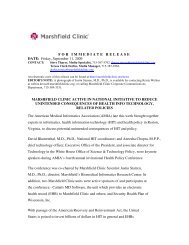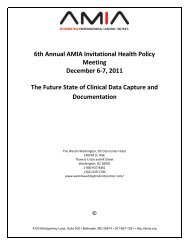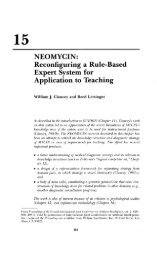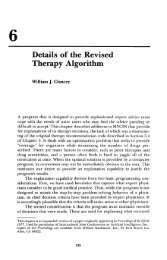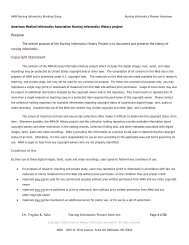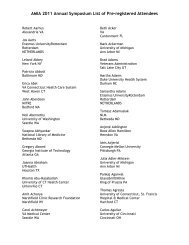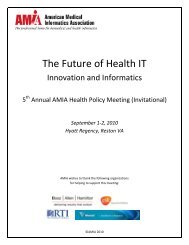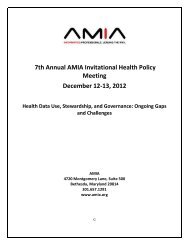Chapter 3 - People
Chapter 3 - People
Chapter 3 - People
Create successful ePaper yourself
Turn your PDF publications into a flip-book with our unique Google optimized e-Paper software.
58 The Evolution of MYCIN’s Rule Formabout problems that had limited the success of previous computer-basedmedical decision-making systems. More recently we have undertaken forrealstudies of physician attitudes (<strong>Chapter</strong> 34), and the data that resulted,coupled with our prior experience building MYCIN, have had a majorimpact on our more recent work with ONCOCIN (<strong>Chapter</strong> 35). Theseissues are addressed in detail in Part Eleven.However, since many of the features and technical decisions that arereflected in the other chapters in Part Two are based on our early analysisof design considerations for MYCIN (Shortliffe, 1976), we summarizethose briefly here. We have already alluded to several ways in which MY-CIN departed from the pure production systems described in <strong>Chapter</strong> 2.These are further discussed throughout the book (see especially <strong>Chapter</strong>36), but it is important to recognize that the system’s development wasevolutionary. Most such departures resulted from characteristics of themedical domain, from our perceptions of physicians as potential computerusers, or from unanticipated problems that arose as MYCIN grew in sizeand complexity.We recognized at the outset that educational programs designed forinstruction of medical students had tended to meet with more long-termsuccess than had clinical consultation programs. A possible explanation,we felt, was that instructional programs dealt only with hypothetical patientsin an effort to teach diagnostic or therapeutic concepts, whereasconsultation systems were intended to assist physicians with the managementof real patients in the clinical setting. A program aiding decisionsthat can directly affect patient well-being must fulfill certain responsibilitiesto physicians if they are to accept the computer and make use of its knowledge.For example, we observed that physicians had tended to reject computerprograms designed as decision-making aids unless they wereaccessible, easy to use, forgiving of simple typing errors,, reliable, and fastenough to save time. Physicians also seemed to prefer that a programfunction as a tool, not as an "all-knowing" machine that analyzes data andthen states its conclusions as dogma without justifying them. We had alsoobserved that physicians are most apt to need advice from consultationprograms when an unusual diagnostic or therapeutic problem has arisen,which is often the circumstance when a patient is acutely ill. Time is animportant consideration in such cases, and a physician will probably beunwilling to experiment with an "unpolished" prototype. In fact, time willalways be an important consideration given the typical daily schedule of apracticing physician.With considerations such as these in mind from the start, we definedthe following list of prerequisites for the acceptance of a clinical consultation3 program (Shortliffe et al., 1974):3This analysis was later updated, expanded, and analyzed after we gained more experiencewith MYCIN (Shortliffe, 1980).



